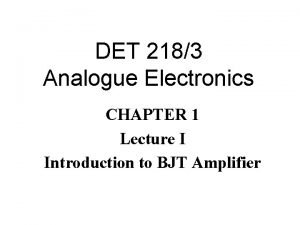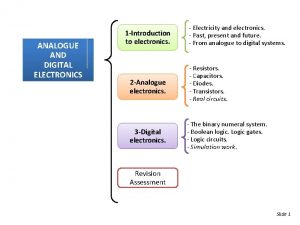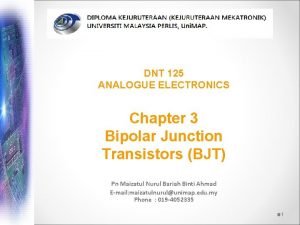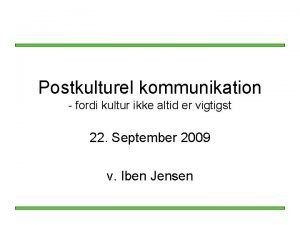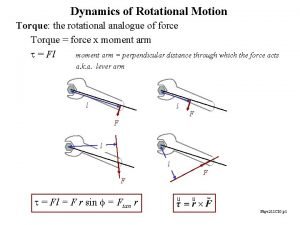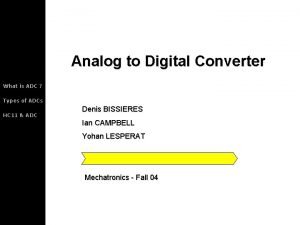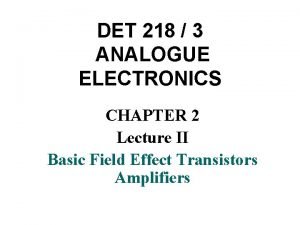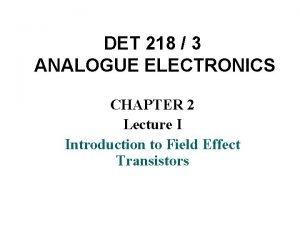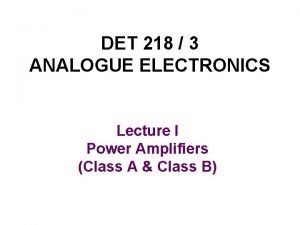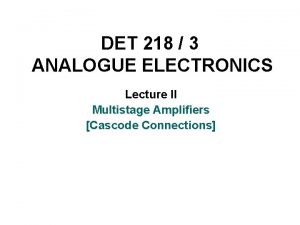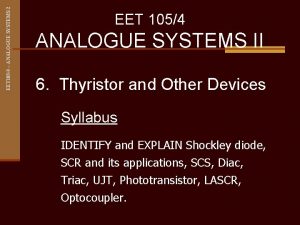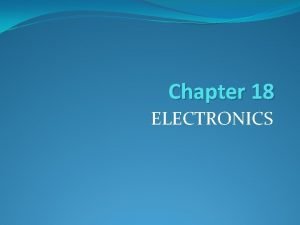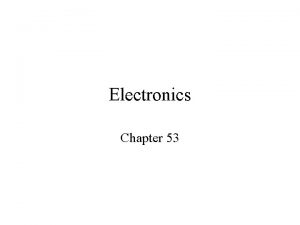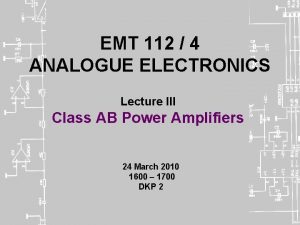DET 2183 Analogue Electronics CHAPTER 1 Lecture I
















- Slides: 16

DET 218/3 Analogue Electronics CHAPTER 1 Lecture I Introduction to BJT Amplifier

BJT REVIEW (I) The emitter current (i. E) is the sum of the collector current (i. C) and the base current (i. B) i. B << i. E and i. C LECTURE I (b): BJT REVIEW

BJT REVIEW (II) • Common-emitter current gain, β (Also knows as DC Current gain) – Range: 50 < β < 300 • Common-base current gain, α (Also knows as DC alpha) – Range: always slightly less than 1 • The current relationship between these 2 parameters are as follows: LECTURE I (b): BJT REVIEW

BJT REVIEW (III) • BJT as amplifying device – B-E junction is forward-biased – B-C junction is reverse-biased In a configuration called Forward Active Operating mode or ( Active Region) LECTURE I (b): BJT REVIEW

COMMON-EMITTER (CE) CIRCUIT (a) with an npn transistor (b) with a pnp transistor (c) with a pnp transistor biased with a positive voltage source LECTURE I (b): BJT REVIEW

CE CIRCUIT: DC ANALYSIS (I) Transistor currentvoltage characteristics of the common-emitter circuit LECTURE I (b): BJT REVIEW

CE CIRCUIT: DC ANALYSIS (II) Common-emitter circuit with an npn transistor Common-emitter dc equivalent circuit, with piecewise linear parameters LECTURE I (b): BJT REVIEW

CE CIRCUIT: DC ANALYSIS (III) Usually VBE(on) = 0. 7 V Power dissipated in the transistor is : LECTURE I (b): BJT REVIEW

DC ANALYSIS: Load Lines & Modes of Operation (I) Figure A Base-emitter junction characteristics and the input load line Based on Figure A, using KVL around B-E loop: LECTURE I (b): BJT REVIEW

DC ANALYSIS: Load Lines & Modes of Operation (II) Based on Figure A, 2 end points of the load line are found by setting IC = 0 So, VCE = VCC = 10 V When VCE = 0, IC = VCC/RC = 5 m. A IBQ is the value from the previous slide = 15 µA So, ICQ = βIBQ If β = 200, ICQ = 3000 µA = 3 m. A Common- emitter transistor characteristics and the collector-emitter load line So, VCEQ = 4 V LECTURE I (b): BJT REVIEW

BJT: an AMPLIFIER • Amplification of a small ac voltage by placing the ac signal source in the base circuit • Vin is superimposed on the DC bias voltage VBB by connecting them in series with base resistor RB: • Small changes in the base current circuit causes large changes in collector current circuit LECTURE I (b): BJT REVIEW

BJT CURRENT RELATIONSHIPS 1. Given that a common-emitter current gain β = 150 and a base current i. B = 15 µA. Assume that the transistor is biased in the forward-active mode. Determine: (i) (iii) collector current i. C , emitter current i. E and common-base current gain α. 2. Transistors of a particular type have common-base current gains in the range of 0. 980 ≤ α ≤ 0. 995. Determine the corresponding range of common-emitter current gain β.

BJT CURRENT RELATIONSHIPS 3. The common-emitter current gains of two transistors are β 1 = 75 and β 2 = 125. Determine the common-base current gains, α 1 and α 2. 4. An npn transistor is biased in the forward-active mode. The base current is i. B = 9. 60 µA and emitter current, i. E = 0. 780 m. A. Determine: (i) (iii) common-emitter current gain β, common-base current gain α, and collector current i. C.

BJT CURRENT RELATIONSHIPS 5. The emitter current in a pnp transistor biased in the forward-active mode is i. E = 2. 15 m. A. The common-base current gain α = 0. 990. Determine: (i) (iii) common-emitter current gain β, base current i. B , and collector current i. C.

BJT COMMON-EMITTER AMPLIFIER – DC ANALYSIS VBE(ON) = 0. 7 V 1. Determine: (i) (iii) (iv) β = 200 base current IB , emitter current IE , collector current IC collector-emitter voltage, VCE and Figure 1

BJT COMMON-EMITTER AMPLIFIER – DC ANALYSIS 2. The circuit elements in Figure 1 are changed to VCC = 5 V, VBB = 2 V, RC = 4 kΩ, and RB = 200 kΩ Determine: (i) (iii) (iv) base current IB , emitter current IE , collector current IC and collector-emitter voltage, VCE
 B 2183 tos
B 2183 tos Analogue and digital electronics
Analogue and digital electronics Analogue chapter 3
Analogue chapter 3 Det beskrivende og det komplekse kulturbegreb
Det beskrivende og det komplekse kulturbegreb Stenpelare och gud
Stenpelare och gud Torque is rotational analogue of
Torque is rotational analogue of Analogue and digital transmission in computer networks
Analogue and digital transmission in computer networks Flash adc advantages and disadvantages
Flash adc advantages and disadvantages Write in digital time
Write in digital time Analog vs digital
Analog vs digital Analogue door phone
Analogue door phone Analogue studies are used when researchers ____.
Analogue studies are used when researchers ____. Sadq h10
Sadq h10 Stelarc ear
Stelarc ear Status digital analogue
Status digital analogue 01:640:244 lecture notes - lecture 15: plat, idah, farad
01:640:244 lecture notes - lecture 15: plat, idah, farad Digital electronics chapter 1
Digital electronics chapter 1
